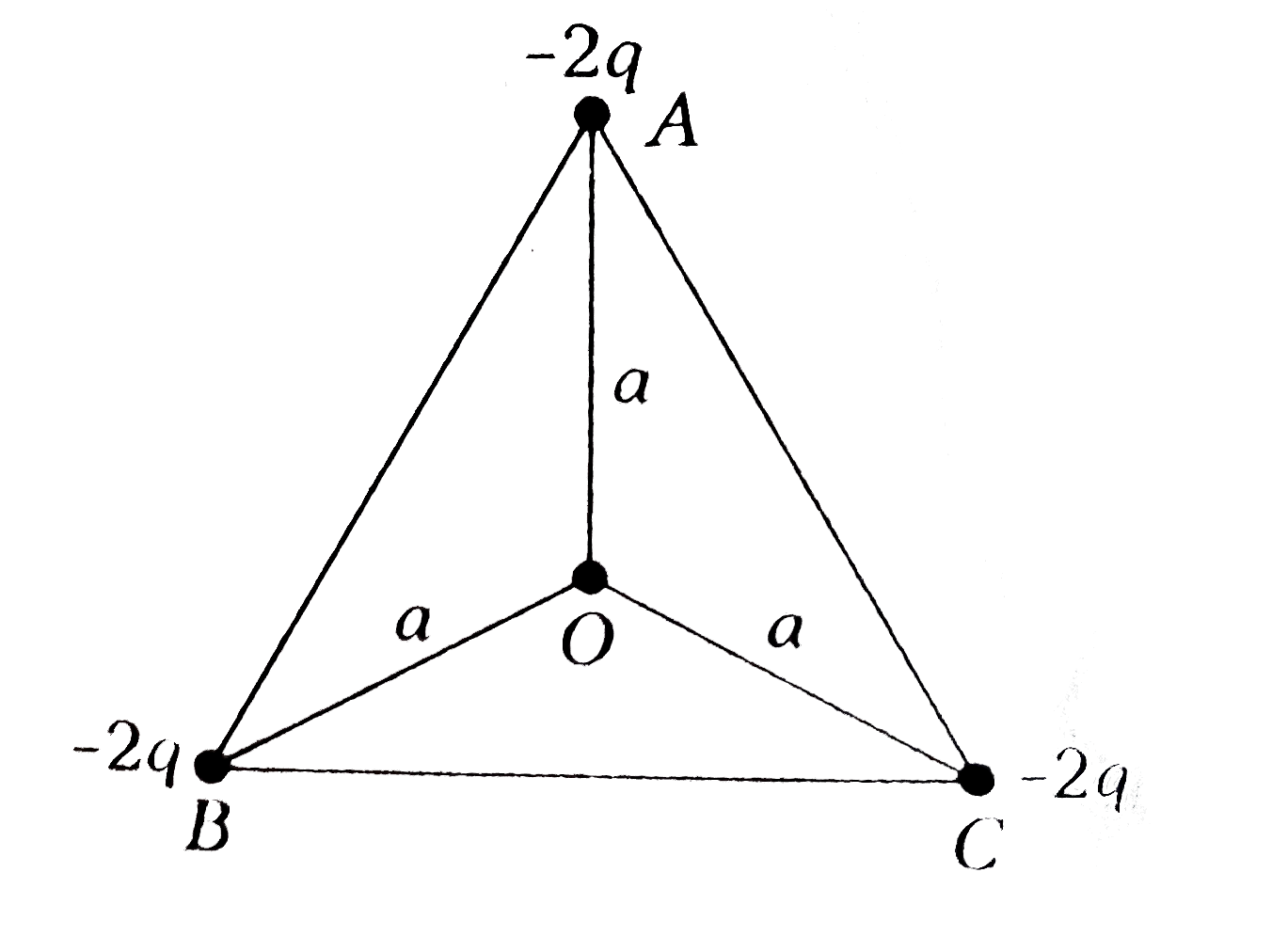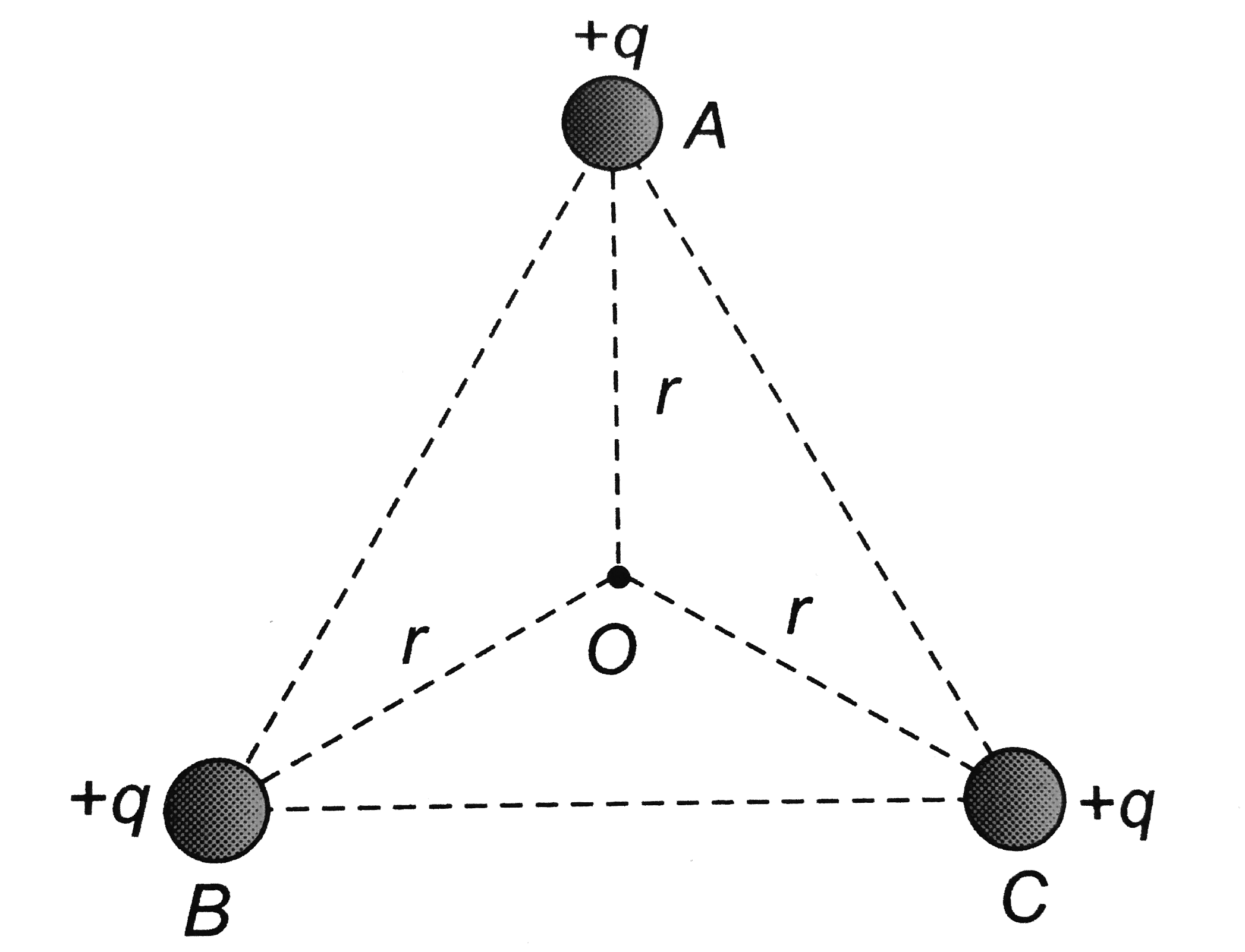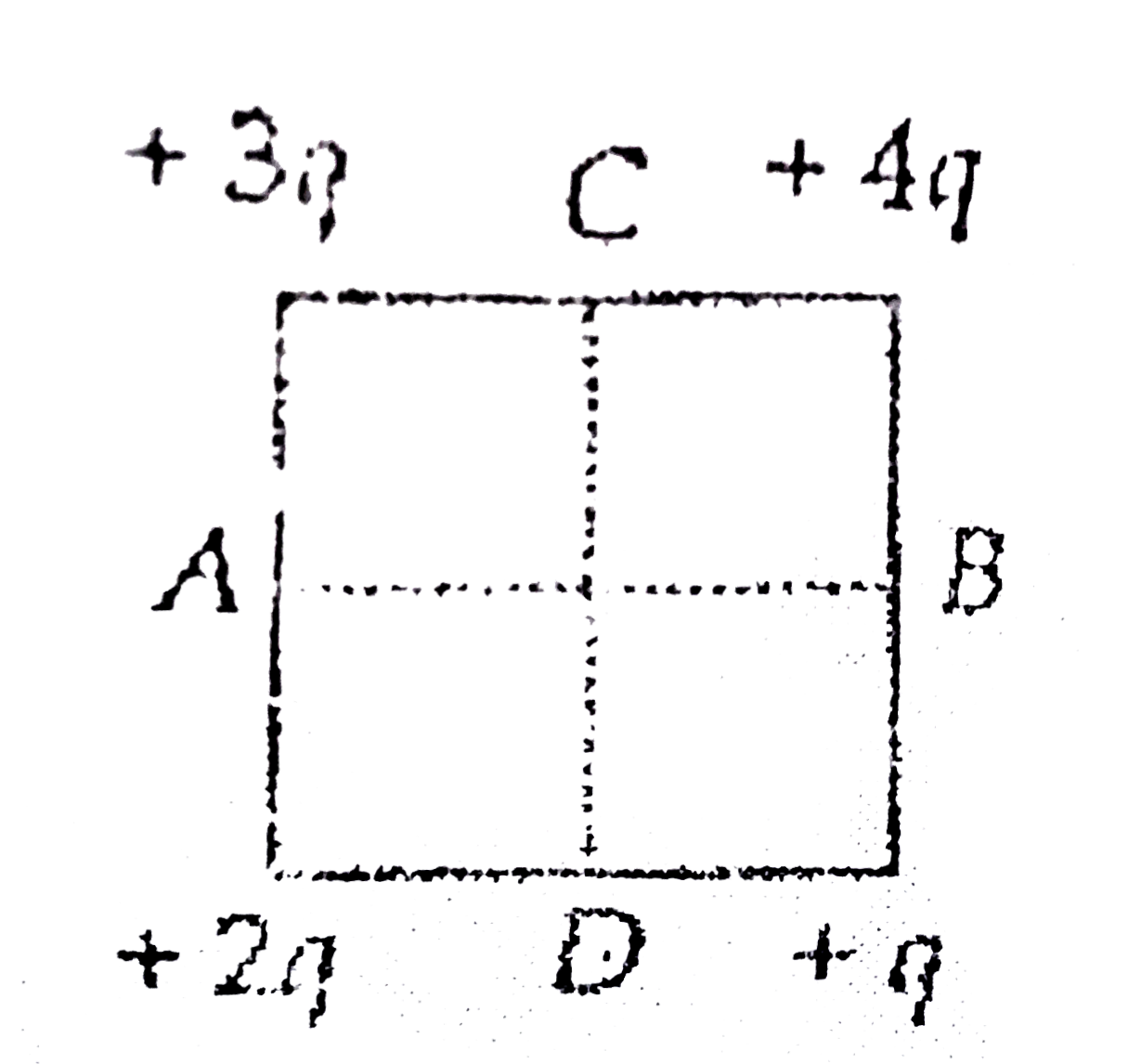At the corners A, B, C of a square ABCD, charges 10mC,−20mCand10mC are placed. The electric intensity at the centre of the square to become zero, the charge to be placed at the corner D is
−20mC
+20mC
30mC
−30mC
The correct Answer is:A
To solve the problem, we need to find the charge q that should be placed at corner D of the square ABCD such that the electric intensity at the center of the square is zero.
1. Understand the Configuration:
- We have a square ABCD.
- Charges are placed at corners A, B, and C:
- Charge at A (QA) = +10mC
- Charge at B (QB) = −20mC
- Charge at C (QC) = +10mC
- We need to find the charge at D (QD) such that the electric field at the center of the square is zero.
2. Electric Field Calculation:
- The electric field E due to a point charge is given by:
E=k|Q|r2
where k is Coulomb's constant, Q is the charge, and r is the distance from the charge to the point where the field is being calculated.
3. Distance to the Center:
- The distance from each corner of the square to the center is r=x√2, where x is the length of the side of the square.
4. Electric Field Contributions:
- The electric field at the center due to charge at A:
EA=k10×10−3(x√2)2=k10×10−3⋅2x2=20k×10−3x2
- The electric field at the center due to charge at B:
EB=k20×10−3(x√2)2=k20×10−3⋅2x2=40k×10−3x2
(Note: This field is directed towards B since B is negatively charged)
- The electric field at the center due to charge at C:
EC=k10×10−3(x√2)2=20k×10−3x2
5. Net Electric Field at the Center:
- The net electric field at the center due to charges at A, B, and C is:
Enet=EA+EC−EB
Enet=20k×10−3x2+20k×10−3x2−40k×10−3x2
Enet=40k×10−3x2−40k×10−3x2=0
6. Condition for Zero Electric Field:
- To achieve zero electric field at the center, the electric field due to charge QD at D must balance the net field due to A, B, and C.
- The electric field due to charge QD at the center is:
ED=k|QD|(x√2)2=k|QD|⋅2x2
- Setting ED equal to the net electric field from A, B, and C:
k|QD|⋅2x2=40k×10−3x2
- Simplifying gives:
|QD|⋅2=40×10−3
|QD|=20×10−3mC
7. Determining the Sign of Charge QD:
- Since the net electric field due to A and C is positive (both are positive charges), QD must be negative to balance it out.
- Therefore, QD=−20mC.
Final Answer:
The charge to be placed at corner D is QD=−20mC.
- We have a square ABCD.
- Charges are placed at corners A, B, and C:
- Charge at A (QA) = +10mC
- Charge at B (QB) = −20mC
- Charge at C (QC) = +10mC
- We need to find the charge at D (QD) such that the electric field at the center of the square is zero.
- The electric field E due to a point charge is given by:
E=k|Q|r2
where k is Coulomb's constant, Q is the charge, and r is the distance from the charge to the point where the field is being calculated.
- The distance from each corner of the square to the center is r=x√2, where x is the length of the side of the square.
- The electric field at the center due to charge at A:
EA=k10×10−3(x√2)2=k10×10−3⋅2x2=20k×10−3x2
- The electric field at the center due to charge at B:
EB=k20×10−3(x√2)2=k20×10−3⋅2x2=40k×10−3x2
(Note: This field is directed towards B since B is negatively charged)
- The electric field at the center due to charge at C:
EC=k10×10−3(x√2)2=20k×10−3x2
- The net electric field at the center due to charges at A, B, and C is:
Enet=EA+EC−EB
Enet=20k×10−3x2+20k×10−3x2−40k×10−3x2
Enet=40k×10−3x2−40k×10−3x2=0
- To achieve zero electric field at the center, the electric field due to charge QD at D must balance the net field due to A, B, and C.
- The electric field due to charge QD at the center is:
ED=k|QD|(x√2)2=k|QD|⋅2x2
- Setting ED equal to the net electric field from A, B, and C:
k|QD|⋅2x2=40k×10−3x2
- Simplifying gives:
|QD|⋅2=40×10−3
|QD|=20×10−3mC
- Since the net electric field due to A and C is positive (both are positive charges), QD must be negative to balance it out.
- Therefore, QD=−20mC.
The charge to be placed at corner D is QD=−20mC.
Topper's Solved these Questions
- ELECTRIC CHARGES AND FIELDSBOOK - AAKASH SERIESCHAPTER - ELECTRIC CHARGES AND FIELDSEXERCISE - Practice Exercise
57 Videos
- ELECTRIC CHARGES AND FIELDSBOOK - AAKASH SERIESCHAPTER - ELECTRIC CHARGES AND FIELDSEXERCISE - Exercise-I
80 Videos
- DUAL NATURE OF RADIATION AND MATTERBOOK - AAKASH SERIESCHAPTER - DUAL NATURE OF RADIATION AND MATTEREXERCISE - PRACTICE EXERCISEX
42 Videos
- ELECTRIC FIELD AND POTENTIALBOOK - AAKASH SERIESCHAPTER - ELECTRIC FIELD AND POTENTIALEXERCISE - PROBLEMS (LEVEL-II)
26 Videos
Similar Questions
Three charges each of +4μC are the corners B, C, D of a square ABCD of side 1m. The electric field at the centre .O. of the square is
View SolutionTwo charges +5μC and +10μC are placed 20cm apart. The net electric field at the mid-point between the two charges is
View SolutionTwo charges −10C and +10C are placed 10 cm apart. Potential at the centre of th eline joining the two charges is
View SolutionABC is an equilateral triangle. Charges +q are placed at each corner. The electric field intensity at the centroid of triangle will be
View SolutionABC is an equilateral triangle. Charges −2q are placed at each corner. The electric intensity at O will be

View SolutionABC is an equilateral triangle. Charges +q are placed at each corner. The electric intensity at O will be

View SolutionElectric charges of +10μC,+5μC,−3μCand+8μC are placed at the corners of a square of side √2 m, the potential at the centre of the square is
View SolutionA charge Q is placed at each corner of a cube of side a. The potential at the centre of the cube is
View SolutionFour charges of +q, +q +q and +q are placed at the corners A, B, C and D of s square. The resultant force on the charge at D
View SolutionFour charges are arranged at the corners of a square as shown in the figure. The direction of electric field at the centre of the square is along

View Solution
